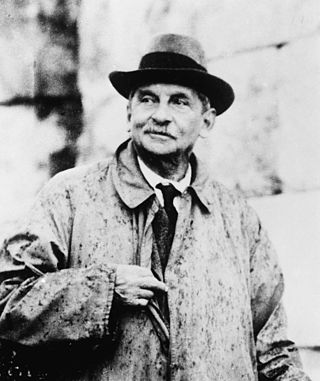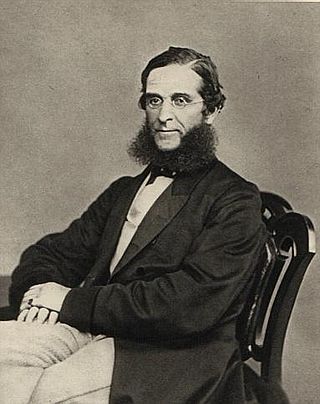
Sir Arthur John Evans was a British archaeologist and pioneer in the study of Aegean civilization in the Bronze Age.

The Ashmolean Museum of Art and Archaeology on Beaumont Street, Oxford, England, is Britain's first public museum. Its first building was erected in 1678–1683 to house the cabinet of curiosities that Elias Ashmole gave to the University of Oxford in 1677. It is also the world's second university museum, after the establishment of the Kunstmuseum Basel in 1661 by the University of Basel.

A fathom is a unit of length in the imperial and the U.S. customary systems equal to 6 feet (1.8288 m), used especially for measuring the depth of water. The fathom is neither an international standard (SI) unit, nor an internationally accepted non-SI unit. Historically it was the maritime measure of depth in the English-speaking world but, apart from within the US, charts now use metres.

The cubit is an ancient unit of length based on the distance from the elbow to the tip of the middle finger. It was primarily associated with the Sumerians, Egyptians, and Israelites. The term cubit is found in the Bible regarding Noah's Ark, the Ark of the Covenant, the Tabernacle, and Solomon's Temple. The common cubit was divided into 6 palms × 4 fingers = 24 digits. Royal cubits added a palm for 7 palms × 4 fingers = 28 digits. These lengths typically ranged from 44.4 to 52.92 cm, with an ancient Roman cubit being as long as 120 cm.

Sir John Evans was an English antiquarian, geologist and founder of prehistoric archaeology.

Lieutenant colonel William Hawley (1851–1941) was a British archaeologist who undertook pioneering excavations at Stonehenge.
Peter Roger Stuart Moorey, was a British archaeologist, historian, and academic, specialising in Mesopotamia and the Ancient Near East. He was Keeper of Antiquities at the Ashmolean Museum of the University of Oxford and also served as Vicegerent of Wolfson College, Oxford.
The megalithic yard is a hypothetical ancient unit of length equal to about 2.72 feet (0.83 m). Some researchers believe it was used in the construction of megalithic structures. The proposal was made by Alexander Thom as a result of his surveys of 600 megalithic sites in England, Scotland, Wales and Brittany. Thom also proposed the megalithic rod of 2.5 megalithic yards, or on average across sites 6.77625 feet. As subunits of these, he further proposed the megalithic inch of 2.073 centimetres (0.816 in), one hundred of which are included in a megalithic rod, and forty of which composed a megalithic yard. Thom applied the statistical lumped variance test of J.R. Broadbent on this quantum and found the results significant, while others have challenged his statistical analysis and suggested that Thom's evidence can be explained in other ways, for instance that the supposed megalithic yard is in fact the average length of a pace.

An ell is a northwestern European unit of measurement, originally understood as a cubit. The word literally means "arm", and survives in the modern English word "elbow" (arm-bend). Later usage through the 19th century refers to several longer units, some of which are thought to derive from a "double ell".

David George Hogarth, also known as D. G. Hogarth, was a British orientalist archaeologist and scholar associated with T. E. Lawrence and Arthur Evans. He was Keeper of the Ashmolean Museum, Oxford from 1909 to 1927.

The School of Athens is a fresco by the Italian Renaissance artist Raphael. It was painted between 1509 and 1511 as part of a commission by Pope Julius II to decorate the rooms now called the Stanze di Raffaello in the Apostolic Palace in Vatican City.
Anne Macaulay was a Scottish musicologist, author and lecturer.
Eric Campbell Fernie is a Scottish art historian.
Sir Alfred William Clapham, was a British scholar of Romanesque architecture. He was Secretary of the Royal Commission on Historical Monuments (England) and President of the Society of Antiquaries.
Rosalind Louisa Beaufort Moss, FSA was a British Egyptologist and bibliographer, noted for her work on The Topographical Bibliography of Ancient Egyptian Hieroglyphic Texts, Reliefs and Paintings.
Papyrus Oxyrhynchus 581 is a papyrus fragment written in Ancient Greek, apparently recording the sale of a slave girl. Dating from 29 August 99 AD, P. Oxy. 581 was discovered, alongside hundreds of other papyri, by Bernard Pyne Grenfell and Arthur Surridge Hunt while excavating an ancient landfill at Oxyrhynchus in modern Egypt. The document's contents were published by the Egypt Exploration Fund in 1898, which also secured its donation to University College, Dundee, later the University of Dundee, in 1903 – where it still resides. Measuring 6.3 x 14.7 cm and consisting of 17 lines of text, the artifact represents the conclusion of a longer record, although the beginning of the papyrus was lost before it was found. P. Oxy. 581 has received a modest amount of scholarly attention, most recently and completely in a 2009 translation by classicist Amin Benaissa of Lady Margaret Hall, Oxford.
Susan Walker is an archaeologist specialising in the study of Roman art. She was previously the Keeper of Antiquities and is currently an Honorary Curator of the Ashmolean Museum, Oxford.

Asthall barrow is a high-status Anglo-Saxon burial mound from the seventh century AD. It is located in Asthall, Oxfordshire, and was excavated in 1923 and 1924.
Jane Elizabeth Ann Masséglia is an ancient historian and Lecturer in Ancient History at the University of Leicester.

Maria Millington Lathbury, Lady Evans (1856–1944) was a classical scholar, archaeologist and numismatist. An alumna of Somerville College, she campaigned for Oxford University to award degrees to women. Along with Ethel Abrahams, she was one of the first female scholars of classical Greek dress. She married the archaeologist John Evans, and their daughter was art historian Joan Evans.











